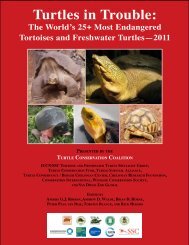You also want an ePaper? Increase the reach of your titles
YUMPU automatically turns print PDFs into web optimized ePapers that Google loves.
CD Long / The Wolverine Foundation<br />
Wolverine have been recovering<br />
in Ontario and have recently been<br />
sighted in the study area.<br />
3.4.2.1 Habitat availability<br />
For each cover type (including footprints),<br />
habitat availability is assessed as the product<br />
of its proportional abundance and its<br />
habitat value. Habitat value is a parameter<br />
that expresses the utility of a cover type to<br />
the species, where 0 indicates no utility and<br />
1 indicates capacity to support the species’<br />
maximum density. All natural land cover<br />
types were assigned a value of 1, given<br />
that wolverines are habitat generalists in<br />
fire-driven landscapes (Justina Ray, pers.<br />
comm.). Research in northwestern Ontario<br />
found wolverine avoid deciduous forest relative to coniferous forest,<br />
but it is thought that the avoidance was due to another underlying<br />
biotic or abiotic variable (Bowman et al. 2010). Footprints were<br />
assigned a value of 0 because wolverine prefer intact habitat.<br />
To account for avoidance and mortality, the habitat value of land<br />
cover in proximity of anthropogenic footprints was reduced by<br />
applying buffers to footprint and down-weighting the value of<br />
habitat within the buffer by a proportional use coefficient (i.e., the<br />
proportion of habitat within the buffer that is used). Buffer widths<br />
and use were based on an HSI model constructed for wolverine in<br />
Alberta (Jokinen 2004), which includes buffer relationships for four<br />
footprint types.<br />
• All weather roads (applied here to major and minor roads): habitat<br />
suitability was reduced by an average of 65% within 1,000<br />
m of the footprint.<br />
• Good weather roads (applied here to winter roads): habitat suitability<br />
was reduced by an average of 50% within 600 m of the<br />
footprint.<br />
• Vegetated linear disturbances (applied here to transmission lines<br />
and railroad): habitat suitability was reduced by an average of<br />
35% within 400 m of the footprint.<br />
• Polygonal footprints (applied here to all other footprint types,<br />
except reservoirs): habitat suitability was reduced by 70% within<br />
700 m of the footprint.<br />
3.4.2.2 Habitat quality<br />
Habitat quality is a value ranging from 0 to 1 that incorporates<br />
the effect of one or more landscape attributes on habitat such as<br />
road density, forest age, and human population density. For each<br />
28 Canadian Boreal Initiative | Wildlife Conservation Society <strong>Canada</strong>







![RaLand / SeaScape [PDF] - Wildlife Conservation Society](https://img.yumpu.com/49974326/1/190x245/raland-seascape-pdf-wildlife-conservation-society.jpg?quality=85)









